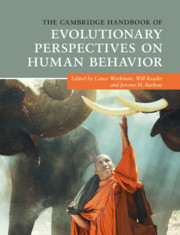Book contents
- The Cambridge Handbook of Evolutionary Perspectives on Human Behavior
- The Cambridge Handbook of Evolutionary Perspectives on Human Behavior
- Copyright page
- Dedication
- Contents
- Figures
- Tables
- Contributors
- Preface
- Acknowledgments
- Part I The Comparative Approach
- Part II Sociocultural Anthropology and Evolution
- Part III Evolution and Neuroscience
- Part IV Group Living
- Part V Evolution and Cognition
- Part VI Evolution and Development
- Part VII Sexual Selection and Human Sex Differences
- 26 Survival, Selection, and Sex Differences in Fear
- 27 The Enigmatic Urge
- 28 Are Humans Peacocks or Robins?
- 29 Human Mate Selection
- 30 Kin Selection and the Evolution of Male Androphilia
- 31 Evolutionary Psychology
- Part VIII Abnormal Behavior and Evolutionary Psychopathology
- Part IX Applying Evolutionary Principles
- Part X Evolution and the Media
- Index
- References
31 - Evolutionary Psychology
Thoughts on Integrating Feminist Perspectives
from Part VII - Sexual Selection and Human Sex Differences
Published online by Cambridge University Press: 02 March 2020
- The Cambridge Handbook of Evolutionary Perspectives on Human Behavior
- The Cambridge Handbook of Evolutionary Perspectives on Human Behavior
- Copyright page
- Dedication
- Contents
- Figures
- Tables
- Contributors
- Preface
- Acknowledgments
- Part I The Comparative Approach
- Part II Sociocultural Anthropology and Evolution
- Part III Evolution and Neuroscience
- Part IV Group Living
- Part V Evolution and Cognition
- Part VI Evolution and Development
- Part VII Sexual Selection and Human Sex Differences
- 26 Survival, Selection, and Sex Differences in Fear
- 27 The Enigmatic Urge
- 28 Are Humans Peacocks or Robins?
- 29 Human Mate Selection
- 30 Kin Selection and the Evolution of Male Androphilia
- 31 Evolutionary Psychology
- Part VIII Abnormal Behavior and Evolutionary Psychopathology
- Part IX Applying Evolutionary Principles
- Part X Evolution and the Media
- Index
- References
Summary
The discussion of evolutionary theory and feminist ideology has existed for decades and has been obstructed by assumptions, generalizations, misunderstandings, and omissions from both points of view. Terminology, in particular, has had important consequences for comprehension. We note, like Barkow (2006), that there is no term that accurately captures the variety of work of those applying Darwinian theory to the study of human behavior. We apply “evolutionary psychology” here as it is a prevalent term that is used currently, but it also reinforces the goal of focusing on human nature as an outcome of biological evolution (Barkow, 2006). To provide as much clarity and simplicity as possible in this chapter, we will refer to evolutionary scientists as “evolutionists” and feminist scholars as “feminists” as they were in Hrdy (1981/1999).
- Type
- Chapter
- Information
- Publisher: Cambridge University PressPrint publication year: 2020
References
- 2
- Cited by



